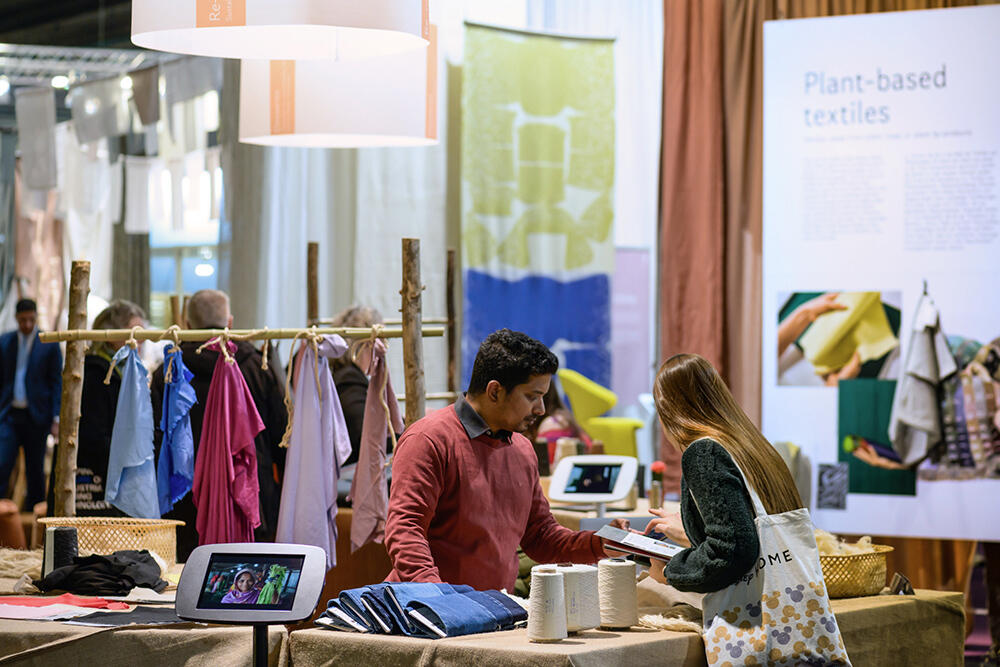Nearly 70,000 visitors descended on Frankfurt, Germany, last week for Heimtextil, the international trade fair for home and contract textiles. Hosting more than 2,800 exhibitors (a number made larger than previous years by the new Carpets & Rugs hall), the sprawling Messe Frankfurt fairgrounds featured miles of exciting products and displays, including the fair’s crown jewel, the always inspiring Trend Space. This year, an accompanying exhibition by futurist design agency FranklinTill took attendees to the forefront of textile innovation, offering demonstrations of AI technology and interactions with representatives from pioneering alternative-materials manufacturers.
After three days of logging miles around the fairgrounds, BOH reports five takeaways on where the textile industry is headed in 2024.
Sustainability sells
From the Fibers & Yarns section to the bedding exhibitors, green bona fides were boasted loudly and proudly throughout the fair. Booth after booth was emblazoned with logos for Oeko-Tex, B Corp, or EU Ecolabel. Judging by the sheer number of companies flaunting their green goods, it seems that eco certifications are more than just a perk—they’re becoming a baseline status for attracting new business.

Alternative materials abound
Alternative materials like Tencel and bamboo could be found throughout the halls, but the Trend Space showcased even more experimental fabrics. There was Noosa, a company that manufacturers a cottonlike fiber made from a corn byproduct, and then Flocus, which takes the fruit of the kapok tree and makes it into a biodegradable yarn that is naturally antibacterial and temperature regulating. Also on display was a variety of leather alternatives—companies like Oleatex use waste from the olive industry to make vegan leather, while Desserto uses nopal cactus to make its wide-ranging line. There were also varieties made from persimmon, mycelium and bamboo, making the category dense with competition and chock-full of exciting options.
The greening of polyester
While leather made from products you could find in the Whole Foods produce section is exciting and innovative, polyester still accounts for over three quarters of the global fiber market. Unseating it with fibers made from more natural materials is unlikely, something the textile industry (not to mention the polyester manufacturers) is keenly aware of. In lieu of replacing it altogether, several solutions are underway to make crude-oil-based synthetic fiber more sustainable. Two exhibitors at Heimtextil, Fiberpartner and Ciclo, have developed solutions that can be added to polyester during the manufacturing process to combat the release of microplastics, which the material sheds during use and washing. The additive makes it so that the microfibers that do end up in the water supply can biodegrade, something they otherwise wouldn’t be able to do. While many alternative materials are only available on a small scale, both Fibre Partner and Ciclo and Fiberpartner’s PrimaLoft Bio are already commercially available.

Innovations in dye
The textile dyeing process is among the largest water consumers in the world, accounting for over 5 trillion liters per year. With its use of petrochemical dyes and a host of toxic and polluting chemicals, it’s also a big environmental burden. Heimtextil highlighted two companies attempting to mitigate that impact: Colorifix and Ever Dye. Colorifix is using digital DNA sequencing to bioengineer dye in a process similar to brewing beer or kombucha. The result is a brothlike dye made without the use of toxic chemicals. The company is already working with H&M on apparel applications, with plans to expand into home textiles and soft goods. Ever Dye is tackling the energy consumption aspect of the industry with a process that uses minerals like iron to create dyes that can adhere to fabric at room temperature instead of at the high heat that darker hues usually require.
AI is here to stay
While conversations about the looming industry impact of AI might elicit eye rolls from some, the technology was very much a part of the goings-on in Frankfurt last week. In the Trend Space, Danish virtual and augmented reality production company Mannd set up an interactive tutorial that let attendees explore generative AI, creating images of textiles using the Midjourney platform. Elsewhere at the fair, a company called NewRetex explained how they use an AI algorithm to sort recycled textiles and weave them into new fibers, while Danny Richman of the U.K.–based FabricGenie discussed how his platform uses AI to design fabric on-demand. With both flashy and practical applications on display, it seems clear that AI will play a role in the evolution of the textile industry moving forward.





























